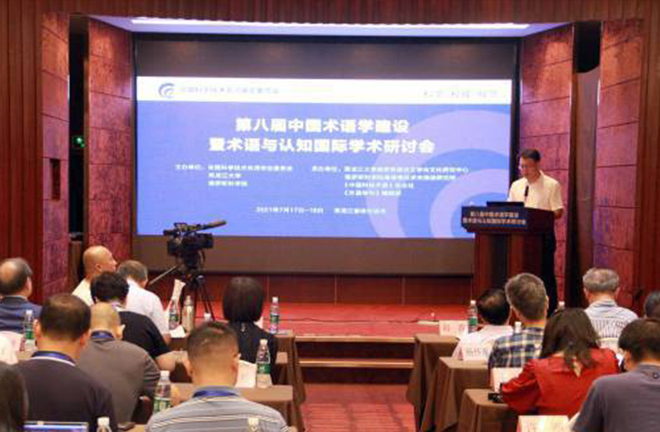Seminar advocates social application of terminology

A terminological seminar in Harbin, Heilongjiang Province, July 17 Photo: Zhao Xuzhou/CSST
HARBIN—The Eighth International Seminar on Chinese Terminology Construction was held in Harbin, Heilongjiang Province, on July 17. Scholars exchanged views on terminological interactions in East-West scientific, technological, and cultural exchanges.
Social application
China has a long history of terminological research. Erya, the earliest surviving Chinese lexicon, possibly compiled in the Warring States Period (475–221 BCE) or Han Dynasty (206 BCE–220), already paid attention to language norms. Ancient China made brilliant achievements in science and technology and produced a huge terminological heritage with unique Chinese ideological and cultural characteristics, contributing to global society’s science and technology.
In addition to examining terminology and its application to science and technology circles and scientific and technological education, scholars need to investigate the social application of terminology. Terminological research facilitates the entrance of scientific and technological products into social life, and rapidly lifts the scientific and technological content of social life, satiating social needs for terminologies at various levels and aspects.
Li Yuming, president of the Lexicographical Society of China and former secretary of the Party committee of Beijing Language and Culture University, summed up four major fields of terminological research in China: ontoterminology, terminological application to different disciplines, terminological education, and social life of terminology. A good use of scientific and technological terms in social life facilitates the application of scientific and technological achievements in social life, and enhances social support for scientific and technological development. The social application of terminology manifests technology’s impact on society and the technological content of social life.
Cognitive artificial intelligence
Cognitive science, which began in the mid-1950s with the aim of conducting interdisciplinary research on the mind and intelligence, has gradually penetrated into many other disciplines including philosophy, psychology, linguistics, anthropology, computational intelligence, and neuroscience, becoming the source driving the new generation of artificial intelligence from perceptual intelligence to cognitive intelligence.
According to Yi Mianzhu, a professor from the Russian department at Information Engineering University (Luoyang), terminologists need to track the developments of cognitive artificial intelligence, grasp the essence of the cognitive research orientations of natural language processing, and reveal the cognitive mechanisms in the generation, recognition, processing, and understanding of natural languages, seeking a new path for emerging cognitive artificial intelligence. The analysis of cognitive terminology oriented towards natural language processing should concentrate on the research goal of emerging cognitive artificial intelligence, and strive to build cognitively graspable and technically operable research paradigms, propelling a new generation of artificial intelligence from perceptual intelligence to cognitive intelligence.
Ways forward
The Chinese translation of English terms began in the 19th century. Since the early 20th century, standardizing translated terms gradually gained importance, but the effect at the time was not obvious, and the phenomenon of multiple translations of one word continued. With the establishment of the China National Committee for Terms in Sciences and Technologies in 1985, terminologies of various disciplines were gradually reviewed and issued, greatly enlarging the promotion and application of normative terms.
Gao Yongwei, dean of the College of Foreign Languages and Literature at Fudan University, noted problems remaining in the standardization of translated terms, such as less-than-timely standardization of new terms, inconsistent translations of the same term in adjacent disciplines, and unidiomatic or unstandardized English translated names. An efficient terminology deliberation mechanism should be established, diversifying review members’ backgrounds and incorporating social forces in the terminology approval process.
“International terminological research presents the development trend of regionalization and nationalization,” said Sun Huan, a professor from the Foreign Languages Department at Harbin Engineering University. As a constituent of international terminology, Chinese terminology should learn from general terminological research methods. More importantly, terminologists are tasked with finding new perspectives and new research methods suitable for Chinese terminology. From “introduction” to “establishment,” building the theoretical system of Chinese terminology should prioritize systematic ontology research on Chinese terminology based on its actuality and features.
“Terminology, a product of history and culture, requires research combining China’s extensive and profound national culture and coherently linguistic development history,” suggested Ye Qisong, director of the Center for Russian Language Literature and Culture Studies at Heilongjiang University. It is advisable to illuminate relationships between terminology and history and culture, follow the historical trajectory of how Chinese terminological forms and semantics evolved, and refine work experience from past terminologists.
Edited by YANG LANLAN

 PRINT
PRINT CLOSE
CLOSE